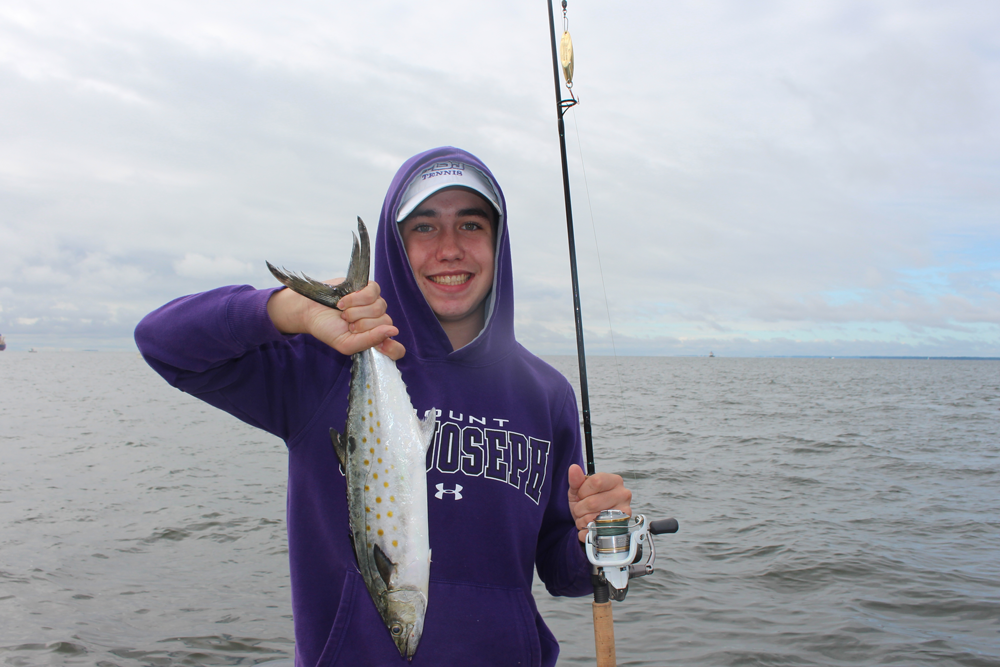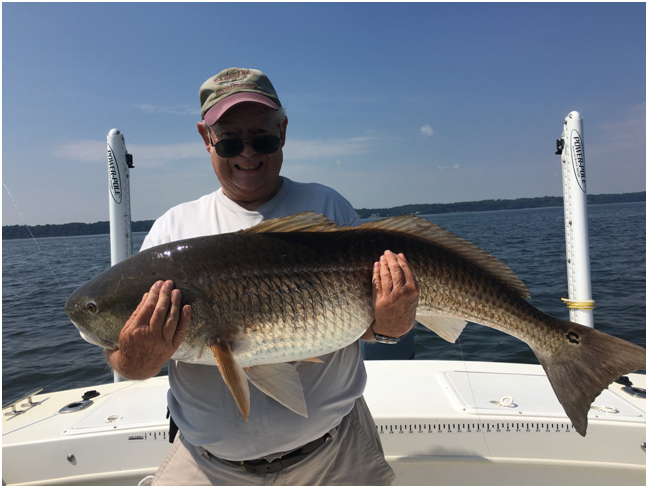9/29/2017 Lower Chesapeake Bay Fishing Report Update:
J & W reports that spot fishing in the Lower Bay is still on, and many are holding on hard bottoms. A good day of spot fishing has turned into a great day of rock fishing for many anglers who are live-lining. The channel ledges near Point Lookout have been a hotspot for the live-liners, although bluefish have been terrorizing the area. If you spot birds in this zone - they have been popping up many days - expect to find a mix of stripers, blues, and some Spanish mackerel. Casting tooth-proof jigs and metal spoons (whites and natural silvers or pearl colors are working best) is the top way for catching the blues and stripers and trolling small spoons is the best way to target the Spanish, which won't stick around a whole heck of a lot longer as water temps cool off.
Farther up the Potomac there have been good numbers of white perch, croaker, (very small) flounder and some puffer fish, as well. Bottom fishermen are doing best on a of these species with bloodworms on bottom rigs.
The Tackle Box reports the red drum bite near the target ships has stayed active, but reminds us that the red drum are a slot fishery and to check your local regulations before heading out. Most of the fish being caught in this area are not inside the slot limit. The channel edges on the eastern side of the Bay have also been a hotspot for the drum. Read up on the tactics for targeting these fish, in Chesapeake Bay Bull Red Drum. If you want to take home reds for the dinner plate, finding slot fish is a better bet in the Tangier Sound right now.
Crabbing has been stellar, and many watermen have continued to fill their baskets into the fall.
9/22/2017 Lower Chesapeake Bay Fishing Report Update:
The Tackle Box reports that the live-lining bite is still hot, with spot plentiful in hard bottomed waters. The channel edge at the mouth of the Potomac is the best bet for live-liners, although a few reports have come in for fish hanging around near the target ships. In addition to rockfish schooling in the Lower Bay, the bluefish are there in full force - and stolen baits can be expected. There is no good way to absolutely combat the blues, however, trolling small spoons has been the best way to get them on board. In addition to the spot found on hard bottom, perch and croaker are in the mix, and J & W reports that the panfish are heavy in the Patuxent.
Unfortunately, the cobia seem to have disappeared and may be done for the season. However they are being replaced by a booming red drum fishery. Most of the drum are being caught are on the eastern side of the target ships, and are taking clam. From the Choptank south, drum can also be found underneath schools of bluefish breaking water, however, the fishery farther south has been more reliable lately.

Spanish mackerel are still throughout the Lower Bay, and the bite for them has been hot enough that most anglers aren't going home disappointed. Trolling small spoons has been the most effective method for targeting them. If you want in on the Spanish now's the time to try, because as the water cools off they can be expected to disappear sooner rather than later. Check out How to Target Spanish Mackerel, for a refresher on tactics and techniques.
9/14/2017 Lower Chesapeake Bay Fishing Report Update:
Perch, croaker, and spot have been plentiful in the Lower Bay region this week, and with live-lining having been so productive recently, the spot are a blessing. Perch and croaker have been especially heavy in the Patuxent and Potomac rivers, and are taking bloodworm and peeler crab fished on bottom. The mouth of the Potomac, especially the drop-offs from Tall Timbers down, remains a good bet for stripers for both live-liners and jiggers.
Large red drum have moved to the eastern side of the target ships according to the Tackle Box, and are a lovely replacement to the cobia fishery, which is quickly fading away with the season's end. J & W reports that many of the fish have been 40 pounds or more, which exceed the legal limit for keeping the fish (redfish must be between 18 and 27 inches to be kept), but makes for one heck of a fun day of catch and release fishing.
Spanish Mackerel are packed tight in the Lower Bay, and we've had reports that many anglers fishing for them are limiting out. Trolling has been the best tactic to target them, and using small spoons has been the best option. Read How to Target Spanish Mackerel, to gain some insight into this fishery.
9/7/2017 Lower Chesapeake Bay Fishing Report Update:
Cobia fishing had significantly slowed down over the past month, and J & W reported that as of earlier this week the cobia had all but moved out of the usual areas. Some cobia remain around the target ships, however sight casters haven’t encountered very many of them. Then in the past few days several boats out of Buzz's encountered good numbers of these fish, while live-baiting with eels - so we're going to call the cobia bite an on-again, off-again thing, right about now.
A more reliable option has been Spanish mackerel, which have been active in the Windmill Point area, above Indian Creek, and throughout the lower Potomac. Number-one spoons have been the best bet for catching them, and some rockfish and a few blues have been mixed in with the catch. Rockfish are also hitting topwater lures around riprap lining the banks of the Potomac, and the majority of fish being caught are 22 to 26 inches according to the Tackle Box.
Plenty of croaker are in the lower bay, and are taking cut bait including peeler crab and bloodworm fished on bottom rigs. Many croaker in the southern bay are significantly bigger than those up North right now, and are far more active. Spot are mixed in with the catch.
Cooler temperatures have improved the already good crabbing in Lower Bay areas, and many crabbers are coming home with their bushel baskets full.
9/1/2017 Lower Chesapeake Bay Fishing Report Update:
The cobia run was great this year, and as of last contact The Tackle Box reported that some are still in the vicinity of the target ships (with live eels providing the best action). Same goes for the Spanish mackerel, which had been chewing through bait off the mouth of St. Jerome Creek, Point No Point, and at times on the Eastern side of the Bay just south of the Little Choptank. The guys at Island Tackle Outfitters note that while scattered mackerel catches have taken place in the Middle Chesapeake Bay areas, heading south to the Lower Bay offers a better opportunity.
Some monster bull reds are around in the Lower Bay and can be found beneath the breaking fish. Jigging metal spoons and plastics down deep is the best way to encounter them and if you missed it, be sure to check out Walleye Pete’s Chesapeake Bay Bull Redfish article which details the tactics and locations you need to know about, to go on a redfish hunt - NOW is the time to make this happen, people!

Bottom fishing has remained strong for perch in the tributaries and for spot in open water, but most of the croaker being caught are small. Interestingly, however, there are some big croaker being caught in the Tangier (see the Tangier Sound report for more info).
The mouth of the Potomac remains a good area for those searching for stripers. Some schools of breaking fish (with blues sometimes mixed in) have begun popping up recently, and the chumming and live-lining bite along the north shore from the mouth of the St. Mary’s River up to Tall Timbers has remained strong. As the water cools down, the numbers of breaking fish should only increase. We’ll also note that crabbing has remained excellent in this region.